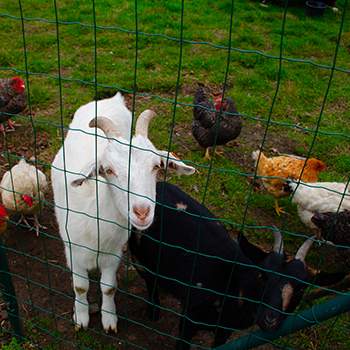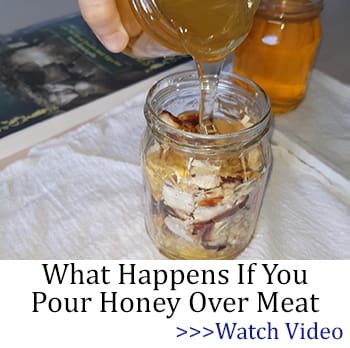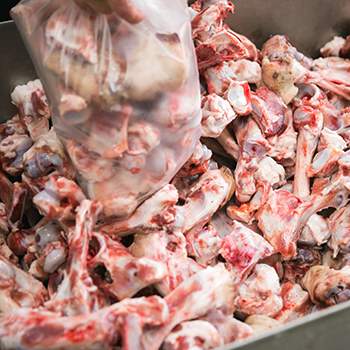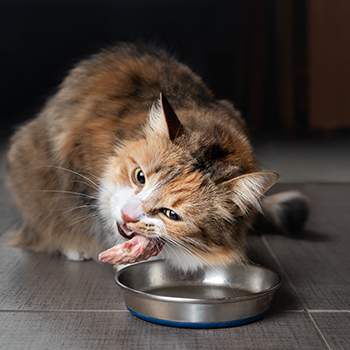My family is on a journey from eating industrial meat to raising it ourselves. This isn’t a quick or simple path because there is so much to learn. We’ve made mistakes and we’ve had great successes. Though we’re still learning, I currently have a pretty good system for making the best use of just about the whole animal.
Diet Is A Very Personal Thing
What to eat is a conscious choice, but it’s deeply influenced by many unconscious factors. There is the comfort of familiarity and the approval of our community. There is the availability and cost of products in our area and the well-funded coercion of advertising. The desires and health issues of the people in our household matter greatly.
It’s not easy to change diet permanently because it takes time and energy to learn new recipes, and money to be able to try out new things. I have to be in a place where I’m experiencing little enough stress that I can watch how my body responds to the changes I make, or I’ll start feeling crummy and reach for the familiar.
That said, there is a very good reason to give up meat as it is usually produced in America. Factory farms are terrible from an animal welfare perspective, and they generate ecological and health effects such as antibiotic resistance, effluent runoff, and atmospheric pollution. It’s a human rights issue, too, with the terrible working conditions in many slaughterhouses. And there is the absurdity of destroying our nation’s soil to produce feed for animals.
So why not go completely vegetarian? That is definitely a good option for some people. But while a plant-based diet has been shown to be healthier for some, an entirely-plant diet does not necessarily produce health for all humans. We are individuals, with different gut microbiomes and health concerns. My family is trying to keep our carbohydrate intake moderate to stave off both diabetes and migraine, as well as feeding growing children. We’ve dealt with some nutrient deficiencies in the past, and we’ve decided it’s best for our health to continue to eat a small amount of meat.
Animals As Part Of A Small-scale Farming System
At our house, we don’t keep any animals specifically for meat. We keep chickens for fly control, eggs, and manure for the garden. We keep goats for weed control, milk, and manure for the garden. Also, we keep geese to keep the predators away from the chickens. They take a lot of work, but it’s worth it because our system would be poorer in every way without these animals.
Half of the baby goats born are male, though, and only a few are good enough to become breeders. Half of the chickens born are roosters, and too many adult roosters sharing a pasture results in carnage. Also, hens and dairy goats eventually reach the end of their productive lives. Or they get injured and must be euthanized, or they are born with a fault that should not be perpetuated.
No matter which way you look at it, keeping livestock of any kind means dealing with some death. Since I’m responsible for this system, it’s my job to ensure there is as little suffering and as little waste as possible.
Waste Is Part Of The Food System
I began learning to use the whole animal before we ever kept livestock. When we started buying local pastured meat instead of the grocery store kind, I noticed I could get different products than I was used to seeing, and for much lower prices. Liver was $2 a pound. Fatback for rendering lard was $2. Feet and bones were $1. When you’re spending $8 a pound for grass-fed ground beef that’s better for the body, the workers, the animal, and the environment, you really take notice of the cheap parts sitting alongside it in the freezer.
Bones, fat, and organs are cheap because of lack of demand, not lack of quality. Pastured fats, in particular, have been shown to have high levels of fat-soluble vitamins such as vitamin D, which 80% of Americans are deficient in. Liver contains lots of vitamin A, and bones are a great source of minerals.
All these less-desirable parts are more nutrient-dense than muscle meat, but with consumer preference being what it is the farmer can only sell so much, and some goes to waste. Wasted parts mean wasted feed, wasted water, and wasted soil. So I started buying less muscle meat and more of these other things, for the health of my body, my bank account, and my local economy.
Everything To Its Highest Use
Now that I raise my meat, I’m aware of exactly how much work it is. Animals need attention every day without fail. They require lots of shoveling of bedding and hauling of water, and they seem to save their emergencies for the least convenient moments. It takes time, energy, practice, and the right tools to process animals for food. To make the best of this time and energy, I try to use every part for its highest use.
When we cull a spare rooster or buck goat, or an injured or elderly hen, meat is reserved for our favorite meat dinners like fajitas and curry. Heart, liver, and kidneys usually go into Cajun dirty rice, another favorite. We’re currently eating meat only at dinner, a pound or two per meal, maybe three nights a week. That’s as much animal husbandry as I care do, thank you very much.
Bones and feet I boil overnight with a splash of vinegar, and the delicious resulting broth replaces meat in many other favorite recipes. We use it as a base for soups and sauces, of course, but I also cook pasta, rice, grits, and beans in broth. This adds protein, calcium and other nutrients, slowing down the absorption of the carbs we don’t want to give up. This is an especially important technique for toddlers who refuse everything but rice or pasta. With bone broth, you can sneak enough calcium into them to support a growing skeleton.
Chicken heads, blood, lungs, and some other organs replace a portion of purchased pet food for our carnivorous farm partners. I give the dog and cats just the things we humans really don’t want to eat, and they are happy to get them. When the broth is finished simmering, I very carefully pick through it, separating any tiny bone from the meat scraps and cartilage. The soft parts go to the dog and cats but they can’t eat any cooked bones, which might splinter and shred their delicate digestive tracts.
I’m aware this doesn’t constitute a complete diet for dogs and cats; ours also eat some balanced commercial pet food, and our cats serve as rodent control so they get wild nutrition, too. They seem to thrive on this diet. As of this moment, I’m not yet soaking and washing hooves for broth. They are going to the dog to satisfy her need to chew, and save me buying dog toys. I’m learning to prepare hides for dog chews as well, but don’t quite have the process refined yet.
Fertilizer And Fly Control
Animal products don’t just provide food for people and carnivores, though. They also feed the garden. The cleaned bones go into the woodstove, and along with the wood ash they eventually fertilize the garden with calcium and phosphorous. Feathers are also buried in the garden as slow-release nitrogen fertilizer.
The uses detailed above account for almost all of the animal but not quite. Goat heads are one part I haven’t learned to utilize in the kitchen yet, although I do have an intriguing recipe. And I have a sausage grinder, but I haven’t made the leap to using home-harvested intestines for sausage. Like I said, we’re in the middle of a journey, not yet at the destination.
For heads, we use a fantastically valuable farm tool called a fly bucket. Flies in the wild follow large animals like cows and pigs, laying eggs on their dung or their dead. Birds similar to chickens usually come along behind and consume the larvae. My neighbors have lots of cows but no chickens, so we are inundated with flies.
I took a five-gallon bucket and drilled small holes all around the bottom, just large enough for flies to get in. The goat head goes in the bucket and I put the lid on. Flies get in through the holes, lay their eggs and then cannot escape, because their instinct is to fly up, not down. The larvae hatch and consume the waste, then crawl out the holes when they are ready to pupate into adults.
I hang the bucket in the chicken stall, and the chickens eat every single larvae. No harmful bacteria transfer from the bucket to the chickens and no irritating flies survive the process. It’s free protein for the flock, helping to support their egg-laying and reducing purchased feed. If I had to buy fly traps I estimate it would cost me over $50 per year to achieve the same fly control, and the commercial fly traps also kill carrion beetles which are a very neat species I would prefer not to harm.
Of all the parts an animal produces, only the rumen of a goat truly goes to waste at my house, and that’s mostly just partly-digested grass. I’m looking forward to improving my skills over time, learning new recipes and making better use of the bounty. Since we don’t yet produce all the cooking fat we need and I’m avoiding the grocery store, I’m going to visit my favorite local pastured farm this week and then render some lard.
Coronavirus Makes Animal Skills Even More Useful
Large companies will get bailouts, but I’m not at all certain our government will succeed at supporting small local farmers to stay in business. They’re already experiencing serious income issues as restaurants and markets close. It’s up to consumers like us to make sure they can move their product.
I hope we do because if things get rough, it’s to all of our advantages to have a neighbor successfully producing food which doesn’t depend as heavily on the shipping industry, or the functioning of far-away cities and towns. By utilizing what would otherwise go to waste, many of us will be able to afford these high-quality foods.
Even if you’re still shopping exclusively at the grocery store, a willingness to acquire new skills and a waste-not-want-not mindset are very valuable. Your favorite cut of chicken or beef may not be available this week. If you can learn to break down a whole bird or use chicken feet to make nutritious, filling broth, you can still eat well through moderate supply chain disruptions. My favorite resource for this is a cookbook called Long Way on a Little by Shannon Hayes, a pastured farmer.
How Do You Make Use Of The Whole Animal?
As we experience coronavirus upheaval we may all end up eating something we usually don’t, and I suggest we see this as an opportunity to discover new favorite recipes. What do you make that uses a less-loved part of the animal? I’d love to try your method.
This article was written by Kara Stiff and first appeared on The Organic Prepper.
You may also like:
What To Do If You See A Bat On Your Homestead 
What really happens when you bury a shipping container (Video)
50 Off the Grid Homesteading Tips and Tricks
How to Adjust the pH in Soil and Water for Abundant Harvests
How to Keep Eggs Fresh for Months with Mineral Oil
If You Have This Plant in Your Backyard, You Will Never Run Out of Soap











Rumen of the goat can be used as a natural pressure cooker. Clean the stomach, prepare the meat with spices and vegetables, then heat cleaned rocks and put everything inside of the stomach. It will slowly cook everything inside using the heat from the rocks and the built up pressure inside of the stomach. This is a very traditional South Chinese goat farmer trick.
THANK YOU!! I have often looked at the fly larvae in the fly traps and wished I could get it to the chickens without all the dead flies.
BTW, my German Shepherds can eat any bones, raw or cooked. However, I understand the concern.